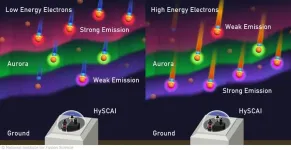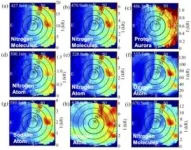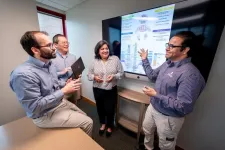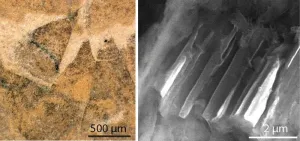(Press-News.org)
Auroras are natural luminous phenomena caused by the interaction of electrons falling from the sky and the upper atmosphere. Most of the observed light consists of emission lines of neutral or ionized nitrogen and oxygen atoms and molecular emission bands, and the color is determined by the transition energy levels, molecular vibrations and rotations. There is a variety of characteristic colors of auroras, such as green and red, but there are multiple theories about the emission process by which they appear in different types of auroras, and to understand the colors of auroras, the light must be broken down. Comprehensive (temporal and spatial) spectral observations are needed to study auroral emission processes and colors in detail.
Complementarily, the National Institute for Fusion Science (NIFS) has been observing the emission of light from plasma in a magnetic field in the Large Helical Device (LHD). Various systems have been developed to measure the spectrum of light emitted from the plasma, and the processes of energy transport and atomic and molecular emission have been studied. By applying this technology and knowledge to auroral observations, we can contribute to the understanding of auroral luminescence and the study of the energy production process of electrons that gives rise to auroral luminescence.
Aurora observation uses optical filters to obtain images of specific colors, which has the disadvantage of a limited acquisition wavelength with low resolution. On the other hand, a hyperspectral camera has the advantage of obtaining a spatial distribution of the spectrum with high wavelength resolution. We started a plan to develop a high-sensitivity hyperspectral camera in 2018 by combining a lens spectrometer with an EMCCD camera, which had been used in the LHD, with an image-sweep optical system using galvanometer mirrors.
It took five years from the planning stage to develop a highly sensitive system capable of measuring auroras at 1kR (1 kilo-Rayleigh). In May 2023, this system was installed at KEOPS at the Swedish Space Corporation's Esrange Space Center in Kiruna, Sweden, which is located just below the auroral belt and can observe auroras with high frequency. The system succeeded in acquiring hyperspectral images of the auroras, that is, two-dimensional images of them broken down by wavelength. Observations began in September 2023, and the data has been acquired remotely in Japan.
Auroral emission intensities and the observation positions were calibrated, based on the positions of stars obtained after installation, and the data will be made publicly available and ready to use. Using the observation data from an aurora break-up that occurred on October 20, 2023, we clarified what kind of data could be viewed using this system. In the process, we estimated the energy of electrons from the intensity ratio of light at different wavelengths, which led to the publication of this paper.
Figure 1 shows the difference in the color of the aurora when electrons arrive at low energies and speeds and when they arrive at high energies and speeds. When the electrons are slow, they emit strong red light at high altitudes. On the other hand, when the electrons are fast, they penetrate to lower altitudes and emit a strong green or purple light. Figure 2 is a two-dimensional image of auroras resolved into each color (wavelength) observed with the state-of-the-art hyperspectral camera. The different distribution by color was observed because the elements that produce the light differ according to the height at which the light is generated. Thus, we have succeeded in developing a device that can obtain two-dimensional images of the various colors produced by the aurora borealis.
From the ratio of the intensity of the red light (630nm) to the purple light (427.8nm), we can determine the energy of the incoming electrons that caused the aurora. Using the hyperspectral camera (HySCAI), which is capable of fine spectroscopy of light, the energy of the incoming electrons during the auroral explosion observed at this time was estimated to be 1600 electron volts (an energy equivalent to the voltage of about 1000 dry-cell batteries). There were no major discrepancies with previously known values, indicating that the observations were valid. The Hyperspectral Camera (HySCAI) is expected to contribute to solving important auroral issues such as the distribution of precipitating electrons, their relationship to auroral color, and the mechanism of auroral emission.
For the first time, a detailed spatial distribution of color (a two-dimensional image), a hyperspectral image of the aurora borealis, has been obtained. Many previous auroral studies have used a system in which light is selected by a filter that passes only certain wavelengths. This system compensates for the disadvantage of observing only a limited number of wavelengths. By observing detailed changes in the spectrum, it will contribute to the advancement of auroral research. On the other hand, the system will also provide insight into energy transport due to the interaction between charged particles and waves in a magnetic field, which is also attracting attention in fusion plasmas. It is expected that this interdisciplinary study will be advanced in cooperation with universities and research institutes in Japan and abroad, and will contribute to the development of worldwide aurora research.
END
Mountain hikes are invigorating. Crisp air and clear views can refresh the soul, but thin air presents an additional challenge for high-altitude birds. ‘All else being equal, bird wings produce less lift in low density air’, says Jonathan Rader from the University of North Carolina (UNC) at Chapel Hill, USA, making it more difficult to remain aloft. Yet this doesn’t seem to put them off. Bar-headed geese, cranes and bar-tailed godwits have recorded altitude records of 6000 m and more. So how do they manage to take to the air when thin air offers ...
Dr. Alva O. Ferdinand, head of the Department of Health Policy and Management at the Texas A&M University School of Public Health, has been named to the Health Resources and Services Administration’s National Advisory Committee on Rural Health by U.S. Secretary of Health and Human Services Xavier Becerra. She will serve a four-year term on the committee, which is comprised of nationally recognized rural health experts tasked with providing recommendations on rural health issues.
Since 2019, Ferdinand has served as director of the Southwest Rural Health Research Center, whose research has impacted federal policies nationwide for more than two decades. ...
A drug that was developed to treat pancreatic cancer has now been shown to increase symptom-free survival in preclinical medulloblastoma models – all without showing signs of toxicity.
Medulloblastoma is the most common malignant brain tumor in children. Survival rates vary according to which one of the four subtypes a patient has, but the worst survival rates, historically at about 40%, are for Group 3, which this research focused on.
Jezabel Rodriguez Blanco, Ph.D., an assistant professor who holds dual appointments at MUSC Hollings Cancer Center and the Darby Children’s ...
MADISON — As they are in many places around the globe, glaciers perched high in the Andes Mountains are shrinking. Now, researchers at the University of Wisconsin–Madison and their collaborators have uncovered evidence that the high-altitude tropical ice fields are likely smaller than they've been at any time since the last ice age ended 11,700 years ago.
That would make the tropical Andes the first region in the world known to pass that threshold as a result of the steadily warming global climate. It also makes them possible harbingers of what's to come for glaciers globally.
"We think these are the canary ...
Scientists at St. Jude Children’s Research Hospital have created a panel that is able to provide a diagnosis for >90% of pediatric cancer patients by sequencing 0.15% of the human genome. The panel is a cost-effective way to test and classify childhood malignancies and to help guide patient treatment. The panel’s performance and validation were published this week in Clinical Cancer Research.
Finding the mutations in a child’s cancer with powerful sequencing technology can lead to better outcomes. Physicians use that knowledge to tailor targeted treatments to the specific cancer-causing mutations affecting each patient. However, current ...
Prior authorization—the process by which a health insurance company denies or approves coverage for a health care service before the service is performed—became standard practice beginning with Medicare and Medicaid legislation in the 1960s.
Although research has uncovered disparities in prior coverage for cancer patients based on race, little has been known to date on the role of prior authorization in increasing or decreasing these disparities.
To learn more about the issue, Benjamin Ukert, PhD, an assistant professor of health policy and management in the Texas A&M ...
UNIVERSITY PARK, Pa. — Snacks provide, on average, about one-fourth of most people’s daily calories. With nearly one in three adults in the United States overweight and more than two in five with obesity, according to the National Institutes of Health, researchers in the Penn State Sensory Evaluation Center are investigating how Americans can snack smarter.
The latest study conducted in the center, housed in the College of Agricultural Sciences, investigated how eating behavior changes when consumers are served a dip with a salty snack. The findings, available online now and to be published in the November issue ...
Seven entrepreneurs comprise the next cohort of Innovation Crossroads, a Department of Energy Lab-Embedded Entrepreneurship Program node based at Oak Ridge National Laboratory. The program provides energy-related startup founders from across the nation with access to ORNL’s unique scientific resources and capabilities, as well as connect them with experts, mentors and networks to accelerate their efforts to take their world-changing ideas to the marketplace.
“Supporting the next generation of entrepreneurs is part of ORNL’s ...
FOR IMMEDIATE RELEASE
Aug. 1, 2024
Media Contact:
Monica McDonald
(404) 365-2162
mmcdonald@rheumatology.org
American College of Rheumatology Opens Press Registration for ACR Convergence 2024
ATLANTA – Complimentary press registration is now open for journalists to cover research presented at ACR Convergence 2024, taking place Nov. 14-19 at the Walter E. Washington Convention Center in Washington, D.C. A listing of sessions for the meeting can be found in the online program.
Approved ...
UNDER EMBARGO UNTIL 19:00 BST / 14:00 ET THURSDAY 1 AUGUST 2024
Images available via link in the notes section
Exceptional fossils with preserved soft parts reveal that the earliest molluscs were flat, armoured slugs without shells.
The new species, Shishania aculeata was covered with hollow, organic, cone-shaped spines.
The fossils preserve exceptionally rare detailed features which reveal that these spines were produced using a sophisticated secretion system that is shared with annelids (earthworms and relatives).
A team of researchers including scientists from the University of Oxford have made an astonishing discovery of ...







